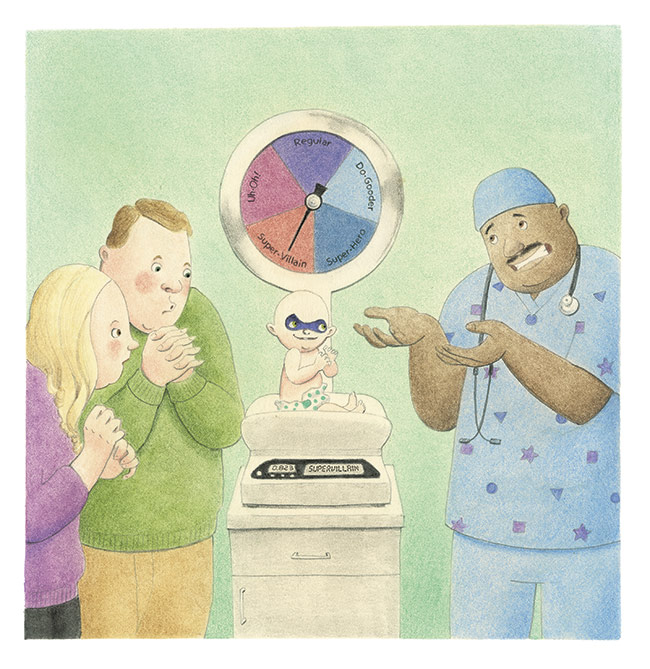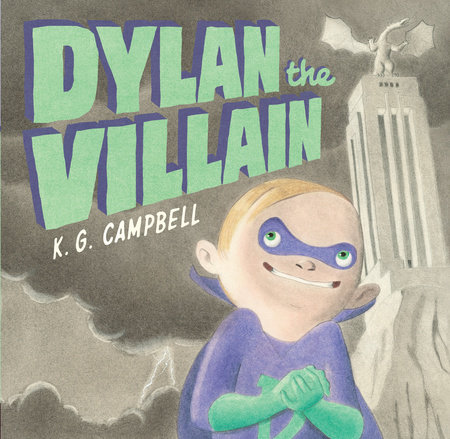Meet the Illustrator: K. G. Campbell
by the Brightly Editors
Today’s Meet the Illustrator features K. G. Campbell, author and illustrator of Lester’s Dreadful Sweaters, The Mermaid and the Shoe, and the recently released Dylan the Villain, and Newbery Award-winning illustrator of Flora and Ulysses: The Illuminated Adventures. K. G. reflects on how his new comical picture book about child super-villains carries on the British legacy of wicked kids in entertainment, shares practical advice for aspiring artists of all ages (even adults!), and more.
What first made you excited about art?
My connection to art was formed prior to my earliest memories. So I actually can’t remember a time when I wasn’t “the kid who loved to draw.” I do, however, recall the mesmerizing effect of watching a sketch emerge beneath my father’s pencil. By “sketch” I really mean a considered doodle — he had some undeveloped raw talent, but at five years old I considered him an artistic genius.
How did you come up with the idea for your new book, Dylan the Villain?
So, the Brits have a long-standing affection for absolutely awful children — from the reprobate pupils of St. Trinian’s and Dennis the Menace (far more nefarious than his American counterpart), to Veruca Salt and Horrid Henry. I really wanted to make a contribution to this beloved genre, and super-villainy provided the perfect, very contemporary vehicle for it.

And where do you find inspiration for your illustrations?
Perhaps because of my proximity to Hollywood, I tend to “cast” my characters. Celebrities, friends, family, ghostly faces in a long-ago daguerreotype, and internet memes can all provide inspiration. I don’t reproduce them verbatim, but rather condense them into a summary, a simplified, exaggerated type. Even one isolated image helps me to imagine and interpret how the resulting character would act, react, and appear in various emotional states.
Beyond that, I can only wonder what on earth we all did before Google Images.
There are some pretty menacing villain names in your book, including the formidable “Addison Van Malice.” Have you come up with a villain name for yourself?
Well I hadn’t! But now that you’ve asked I’ve been racking my brain. I like The Poisoned Pen, but would be surprised if it’s not already taken. How about Cagey Campbell? No, I’ve got it — K. G. Contemptible!
What does your workspace look like?
My space — which is a regular but sunny home office — rather bucks the stereotype. No brush-crowded jars on jar-crowded surfaces all splattered with years’ worth of paint here. I clean thoroughly once a day (if I’m swamped, maybe every other day). Everything is white and a little clinical. You’d be forgiven for mistaking my studio for the office of a doctor in a Swiss sanatorium.
What materials do you most like to use?
To date, my media of choice have been watercolor and colored pencil. The latter permits me to model faces with a lot of form at a small scale. But covering large fields with pencil alone can be a little tedious, so I use a watercolor base to establish richer values and hues more quickly.
I enjoy experimenting with other media. I love, for example, the lyrical, graphic quality of Japanese sumi-e line work and the simple clarity of purist watercolorists like Lisbeth Zwerger. It’s difficult to move past the technique with which you’re most familiar and practiced, but I’m determined at some point to illustrate something in a different medium.
What design resources would you recommend to young artists?
How young are we talking? For kids, I’d say nothing will capture their interest as fully as real world interaction: art classes at school or the library or camp or a local studio. At home, the creative kid will be absorbed for hours with the numerous high quality toys and kits that are well designed to get their artist on.
To the high schooler with talent and a passion for creating I’d say very simply: Go to art school. I didn’t and I still regret it. A little realism and practicality will help you sidestep the starving artist cliché; there are many contemporary industries in which you can carve a career as a creative.
And to the young at heart who start a little later in life (like me), I can’t recommend the internet enough. Don’t get me wrong — real world education is the best bet if you can fit it in. I owe so much to the evening classes, workshops, and conferences I attended. But if you’re short on time, it’s amazing what practical information you can glean from YouTube. And for those who don’t know it, Lynda.com is an amazing resource for online tuition and is particularly strong in visual software like Photoshop and Corel Painter.
What have kids taught you about books and reading?
You can educate yourself about kids’ lit as much as you like. You can attend conferences, listen to publishing professionals and marketing folks, and pay attention to cultural trends. But nothing teaches you as much about what kids like to read as reading with kids. I’m constantly surprised by what captures their attention and what doesn’t. Of course kids are as varied as adults in their tastes. But still, I don’t think anything has influenced my writing as fundamentally as getting in the trenches with them, so to speak.
What’s the best name for a color that you’ve ever heard?
The front door of my old house was painted “Untamed Orange.” The name says it all, but it was less obnoxious than it sounds. Honest!
K. G. Campbell was born in Kenya, but raised and educated in Scotland. He graduated from the University of Edinburgh with a Masters in Art History, but various misadventures led him ultimately to Los Angeles, California. He is the author and illustrator of Lester’s Dreadful Sweaters and Tea Party Rules, as well as the Newbery Award winner Flora and Ulysses: The Illuminated Adventures. Follow K.G. on Twitter @KGCampbell2 or visit him at kgcampbell.com.

